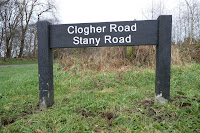The Department for Regional Development (DRD) currently has a Public Transport Reform Consultation, Equality Impact Assessment document [pdf format] out for consultation.
3.10 .. to provide additional transport services across our vast rural communities in line with the Minister’s objective of tackling regional disparities and promoting equality of service.

Perhaps the Minister ought to have a look at the iLink 'smart' card scheme:
iLink is the new integrated smartcard from Translink which provides unlimited day, weekly or monthly bus and rail travel within 3 specified zones across Northern Ireland.
The Pale or #1 Zone is essentially Belfast. Those who wish to venture out into the jungle north of Glengormley are in Beyond the Pale or #2 Zone. Those with more money than sense have entered Beyond Beyond the Pale or #3 Zone as they've sped beyond Antrim. The zones are Belfast centric and Translink have provided a simple calculator to help the traveller work out how much they will be stung.
A card for unlimited daily travel in the comfort of #1 Zone costs £5, for a little less comfort #2 Zone costs £9 and for the rocky road/track experience #3 Zone costs £15.
To get a measure of the inequality Derriaghy to Dundonald and back via the Belfast City Hall is a distance of about 22 miles for £5 in #1 Zone. The less fortunate who do the three mile round trip from Holywood to Cultra are in #2 Zone so they may have a cheaper option than the £9 one. Give a thought for those circling the 11 miles Coleraine triangle all day long, clockwise or anti-clockwise, for the princely sum of £15.
Folks in Derry/Londonderry are paying up to three times as much for a similar but possibly worse public service. Forty years ago there would have indignant protests against such blatant discrimination but not now.










